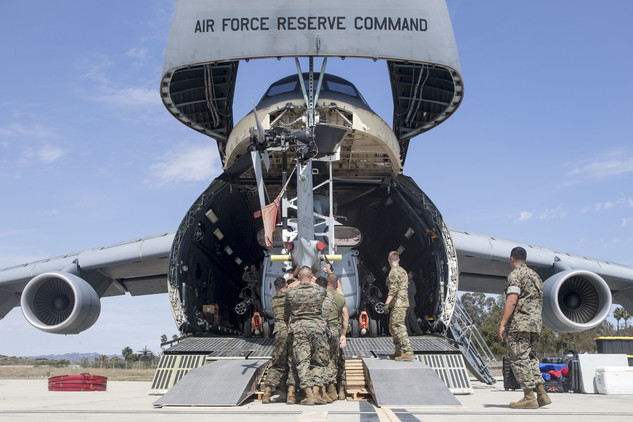
MARINE CORPS BASE CAMP PENDLETON, Calif. — By Lance Cpl. Alison Dostie
Marines and airmen worked together at Marine Corps Air Station Camp Pendleton, California, to strengthen their ability to transport equipment and personnel over long distances using a U.S. Air Force C-5M Super Galaxy, Sept. 16.
The Super Galaxy, with the 433rd Operations Group from Joint Base San Antonio, Texas, landed at MCAS Camp Pendleton to pick up an AH-1Z Viper and UH-1Y Venom helicopter for transportation to Ostrava, Czech Republic, to participate in NATO Days.
NATO Days is the largest air, army and security show in Europe. The purpose is to present to the public the wide variety of resources and capabilities of NATO partner nations. During the event there is a chance to see military hardware exhibitions, police and rescue technology, dynamic shows of special units training, air displays and a first hand look at the different types of equipment used by military units from 18 partner nations.
“We are really happy to get out on this mission and do some joint training and be involved in the NATO Days stuff,” said U.S. Air Force Reserves Capt. David Fink, a pilot with the 68th Airlift Squadron, 433rd Operations Group. “It’s really good for us to get out and see different types of cargo, fly to different airfields, and work with the Marines, and just work on that joint relationship that we have.”
Joint training is important to Marines’ survivability and is beneficial to all involved. Each unit has a variety of skills that can be shared with the whole. Different branches training together is important so when a crisis arises, our nation can fight as a whole.”
MCAS Camp Pendleton is primarily a rotary wing air base, but it does have the capability to support larger aircraft. A C-5 landing at Camp Pendleton provides a more centralized location for movement of personnel and equipment, rather than taking time to transport them on the road. Utilizing MCAS Camp Pendleton guarantees an easily available strategic lift can decrease the logistical burden and time required for the Marines and sailors of I Marine Expeditionary Force or 3rd Marine Aircraft Wing to deploy or conduct operations.
“Some of our capabilities get sometimes overlooked in terms of our strategic position in the theater,” said U.S. Marine Capt. Joseph Leitner, the station adjutant with MCAS Camp Pendleton “Our ability to land aircraft like the C-5, like the C-17, like C-130’s, enhances what we can do to support the warfighter.”
The air station is working hard to expand its ability to support strategic lift aircraft, according to Leitner, and make sure unit planners are aware of the capabilities that exists at Camp Pendleton.

















